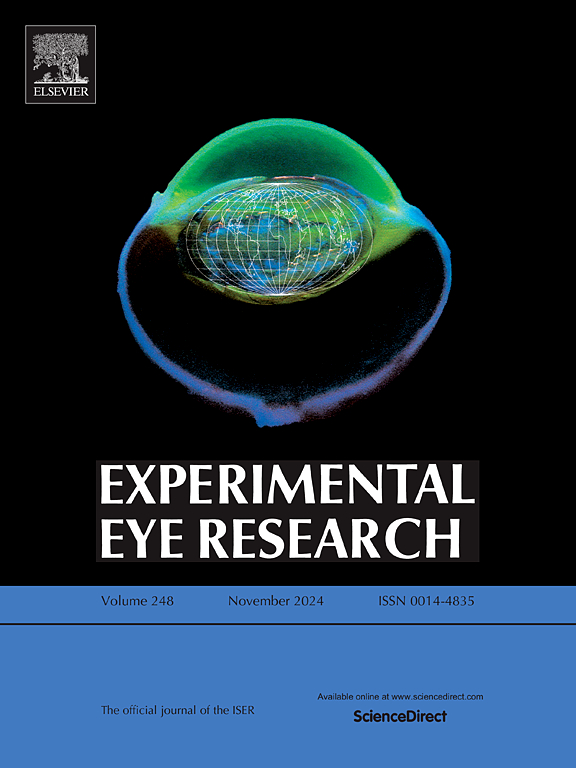青光眼小鼠视网膜神经节细胞样细胞的再生和视神经回路的重建。
IF 3
2区 医学
Q1 OPHTHALMOLOGY
引用次数: 0
摘要
青光眼是一种以成熟神经元-视网膜神经节细胞(RGCs)凋亡、视野缺损和视力丧失为特征的不可逆致盲性眼病。RGCs的再生和视网膜与大脑之间神经连接的重建被认为是促进青光眼患者视力恢复的有效策略。然而,目前在临床实践中还没有有效的再生RGCs来恢复视力的方法。小胶质细胞是一种调节视网膜和中枢神经系统(CNS)免疫反应的胶质细胞,它们是否具有多能性并被逆转为RGCs仍不清楚且具有挑战性。本研究通过体内小胶质细胞命运谱系追踪发现,Brn3b、Sox2、Cbln1、NP1等多个基因(简称BSCN)在小胶质细胞中的异位表达可促进其向rgc样细胞转化。再生的rgc样细胞向远端大脑投射轴突,重建视觉神经回路,恢复视网膜缺血再灌注(I/R)损伤致急性青光眼成年小鼠的视力。此外,再生的rgc样细胞可以稳定存活长达一年,并且在老年急性青光眼小鼠中进行了相同的再生策略,这证实了BSCN重编程再生rgc样细胞的有效性。综上所述,我们已经确定了小胶质细胞是一种新型的重编程种子细胞,并且发现了四个关键基因参与了rgc样细胞的再生以恢复视力。这些发现突出了rgc样细胞再生的新策略,为今后青光眼的治疗提供了理论基础。本文章由计算机程序翻译,如有差异,请以英文原文为准。
Regeneration of retinal ganglion cell-like cells and reconstruction of visual neural circuits in mice with glaucoma
Glaucoma is an irreversible blinding eye disease characterized by apoptosis of mature neurons-retinal ganglion cells (RGCs), visual field defect and vision loss. Regeneration of RGCs and reconstruction of the neural connections between the retina and the brain is considered an effective strategy to promote visual restoration in patients with glaucoma. However, there are currently no effective methods for regenerating RGCs to restore vision in clinical practice. Microglia are a type of glial cells that regulate the immune response in the retina and central nervous system (CNS), whether they have pluripotency and be reversed into RGCs remains unclear and challenging. This study revealed that the ectopic expression of multiple genes (Brn3b, Sox2, Cbln1, and NP1, referred to as BSCN) in microglia can promote their conversion into RGC-like cells by microglia fate lineage tracing in vivo. The regenerated RGC-like cells project axons to the distant brain and reconstruct the visual neural circuit, restoring the impaired vision in adult mice with acute glaucoma induced by retinal ischemia–reperfusion (I/R) injury. Furthermore, the regenerated RGC-like cells could survive stably for up to one year, and the same regeneration strategy was performed in older mice with acute glaucoma, which confirmed the effectiveness of the BSCN reprogramming to regenerate RGC-like cells. In summary, we have identified the microglia as a new type of reprogramming seed cells, and four key genes were found to be involved in regenerating RGC-like cells to restore vision. These findings highlight a new strategy of RGC-like cell regeneration and provide a theoretical basis for treatment of glaucoma in the future.
求助全文
通过发布文献求助,成功后即可免费获取论文全文。
去求助
来源期刊

Experimental eye research
医学-眼科学
CiteScore
6.80
自引率
5.90%
发文量
323
审稿时长
66 days
期刊介绍:
The primary goal of Experimental Eye Research is to publish original research papers on all aspects of experimental biology of the eye and ocular tissues that seek to define the mechanisms of normal function and/or disease. Studies of ocular tissues that encompass the disciplines of cell biology, developmental biology, genetics, molecular biology, physiology, biochemistry, biophysics, immunology or microbiology are most welcomed. Manuscripts that are purely clinical or in a surgical area of ophthalmology are not appropriate for submission to Experimental Eye Research and if received will be returned without review.
 求助内容:
求助内容: 应助结果提醒方式:
应助结果提醒方式:


